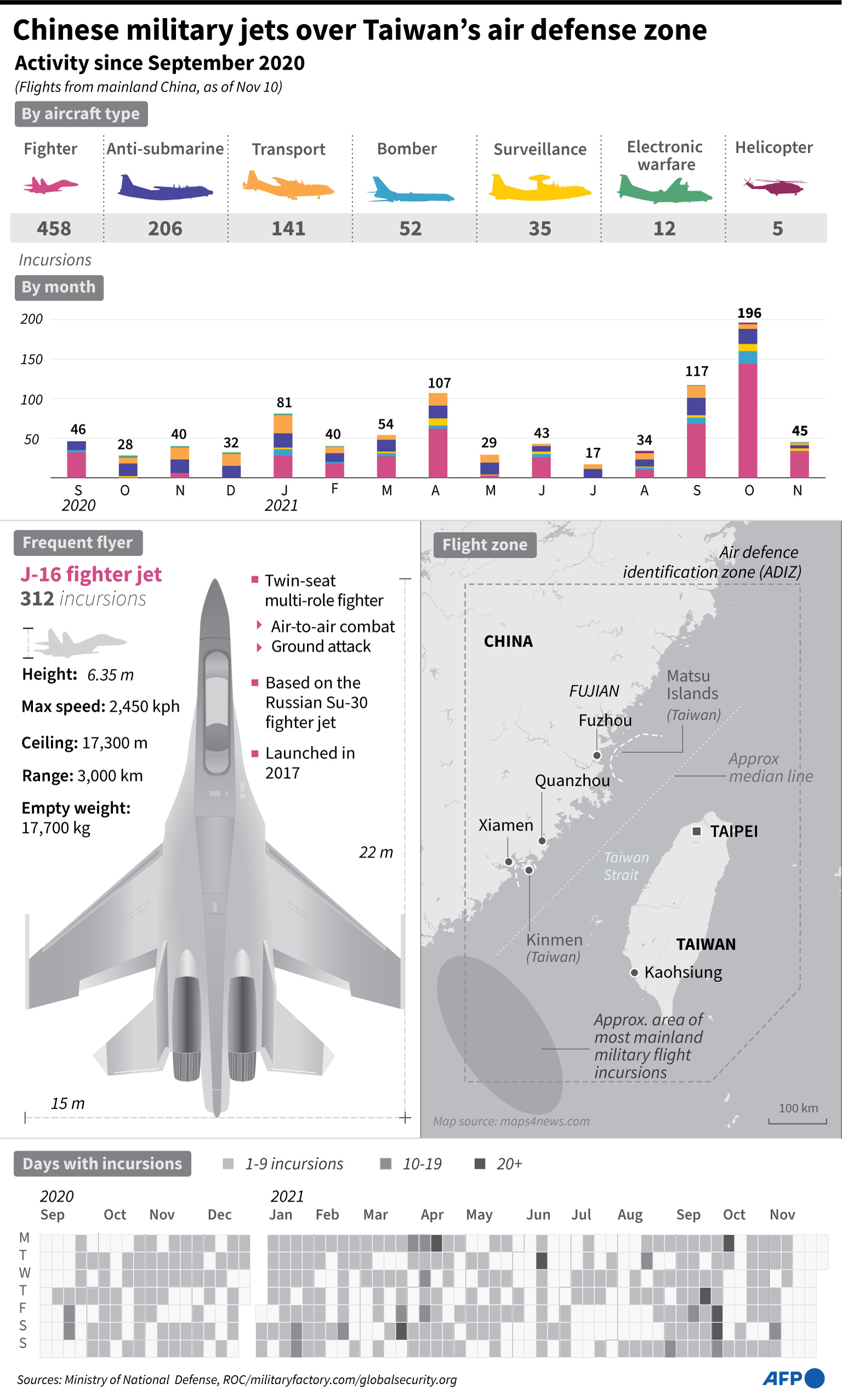The People’s Liberation Army Air Force (PLAAF) has been persistent in its incursions into Taiwan’s air defence identification zone (ADIZ).
Over the past two years, the People’s Liberation Army Air Force (PLAAF) has increased its air activity with near-daily sorties into the Republic of China’s (Taiwan’s) air defence identification zone (ADIZ), which is airspace over land or water in which the identification, location, and control of aircraft ascertained and confirmed in the interest of national security. These incursions can be timed to combine with military drills and exercises in nearby maritime areas.
Tracking data of these incursions shows a change in the makeup of the PLAAF missions. While surveillance aircraft were the most frequently observed, the balance has now tipped to see fighter aircraft dominate the air packages while the inclusion of H-6 bombers, capable of carrying nuclear weapons, has also increased. In 2021 a total of 746 PLAAF aircraft have operated near and inside Taiwan sovereign borders.

Speculation has been growing that this is an indicator that China will attempt to mount an invasion at some point in the near, mid- or longer term future. On 2 October, Taiwan’s defence minister claimed China was capable now, but by 2025 would be in a much better position to launch a ‘full-scale’ invasion.
Historically, large-scale PLAAF activities have been connected to specific events such as China’s patriotic holiday, National Day on 1 October, or signalling Beijing’s grievances over some perceived slight or recent incident. After the US condemned the incursions of 38 planes on 4 October and 39 the next day, China sent more aircraft into the Taiwan ADIZ.

Taiwan MoD
The first package of 52 aircraft included 34 Shenyang J-16 fighter aircraft, derived from the Russian Su-27, and 12 Xian H-6 bombers, derived from the Russian Tu-16, among other aircraft, according to Taiwan’s Ministry of National Defence. Later, four more PLAAF J-16s flew towards the southwestern part of Taiwan’s ADIZ followed on the night of 9 October, by another PLAAF package of four J-16s, a Y-8 reconnaissance aircraft and a PLAN Y-8Q anti-submarine warfare aircraft.

On 14 November, Chinese military forces held a series of air exercises near Taiwan in response to a visit by a US congressional delegation to the island. The Chinese Defence Ministry said that the joint war preparedness patrol, by the PLAAF Eastern Theatre Command was prompted by the serious situation caused by the US mission.
Taiwan’s Republic of China Air Force (ROCAF) scrambled again on 28 November in response to a package of 27 PLAAF aircraft that entered the ADIZ. Taiwan’s Defence Ministry said that tension across the Taiwan Strait had increased as the Chinese President met his top generals. H-6 bombers and six of the fighter aircraft flew close to Taiwan, cutting across the country’s southwestern ADIZ but without crossing into its national air space. The operation itself was not unusual as the PLAAF and PLAN routinely send fighters, bombers and patrol planes around Taiwan ostensibly for training and as a show of force.

But this mission was special in at least one regard. It was the first time the PLAAF had operated one of its new Xian Y-20U tankers along on an ADIZ mission.
The US Air Force has more than 600 strategic tankers, most of them KC-135s. By contrast, the PLAAF had only three Russian Il-78MP Midas tankers until recently as well as over ten tanker-conversions of the H-6 bomber. The Il-78s each can offload up to 230,500lb (104,500kg) of fuel per mission, while the H-6U has an internal fuel payload of some 80,000lb (36,200kg), half of which is available for refuelling operations. It is not clear how much fuel a Y-20U, which is a tanker version of the large military transport, can give away, but the figure is likely to be at least 200,000lb (90,700kg).
China’s vast infrastructure of mainland air bases, not to mention its dozen or so major island outposts plus the PLAN’s growing fleet of aircraft carriers, mitigates the range penalty resulting from the PLAAF’s lack of large tankers for any operations China might conduct along its periphery, such as an attack across the Taiwan Strait.

The current ROCAF inventory includes over 400 combat aircraft, the mainstays being the AIDC F-CK-1 Ching-kou Indigenous Defence Fighter (IDF) while the F-16 and the Mirage 2000-5 provide the ROCAF’s most formidable air-defence capabilities. As part of a $3.8 billion military modernisation project launched in 2016, the ROCAF is upgrading 141of its F-16 A/Bs to the F-16V variant, which is equipped with more advanced avionics, including the Helmet Mounted Cueing System, APG-83 Scalable Agile Beam Radar, and other electronic warfare systems. In addition to the upgrade programme, Taiwan is also buying another 66 new-build F-16V Block 70/72 aircraft from the United States to replace its obsolete fleet of Northrop F-5E/F Tiger II interceptors.
US Secretary of Defense, Lloyd Austin, warned that China’s air incursions by fighter jets, bombers and other warplanes near Taiwan appeared to be rehearsals for military operations against the country. “It looks a lot like them exploring their true capabilities and sure looks a lot like rehearsals,” Austin said in a recent speech at the Reagan National Defense Forum.
by David Oliver













